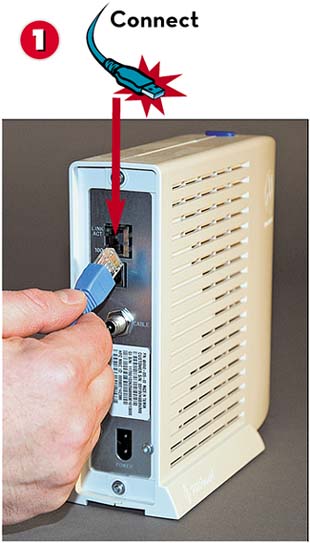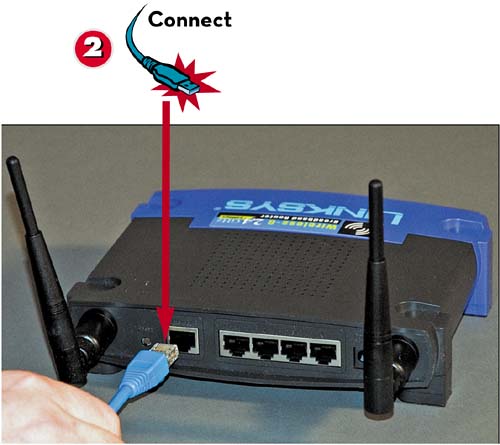The focal point of your wireless network is the wireless router, sometimes called a base station or an access point. The wireless PCs on your network must be connected to or contain wireless adapters, which function as mini-transmitters/receivers to communicate with the base station.


 Connect one end of an Ethernet cable to the Ethernet port on your broadband modem.
Connect one end of an Ethernet cable to the Ethernet port on your broadband modem. Connect the other end of the Ethernet cable to one of the Ethernet ports on your wireless router.
Connect the other end of the Ethernet cable to one of the Ethernet ports on your wireless router.

 Connect one end of an Ethernet cable to another Ethernet port on your wireless router.
Connect one end of an Ethernet cable to another Ethernet port on your wireless router. Connect the other end of the Ethernet cable to the Ethernet port on your main PC.NOTE
Connect the other end of the Ethernet cable to the Ethernet port on your main PC.NOTE Ethernet ConnectionsYour main PC connects to the wireless router via an Ethernet cable. If your main PC doesn’t have a built-in Ethernet port, you’ll need to install an internal network interface card or an external Ethernet adapter via USB.
Ethernet ConnectionsYour main PC connects to the wireless router via an Ethernet cable. If your main PC doesn’t have a built-in Ethernet port, you’ll need to install an internal network interface card or an external Ethernet adapter via USB.

 Connect your wireless router to a power source and, if it has a power switch, turn it on.
Connect your wireless router to a power source and, if it has a power switch, turn it on. On your main PC, click the Start button and click Control Panel.TIP
On your main PC, click the Start button and click Control Panel.TIP Wired and Wireless ConnectionsMost wireless routers include four or more wired Ethernet connectors in addition to wireless capabilities.TIP
Wired and Wireless ConnectionsMost wireless routers include four or more wired Ethernet connectors in addition to wireless capabilities.TIP Broadband RoutersSome broadband modems include built-in wireless routers. If you have one of these, you don’t need to buy a separate router.
Broadband RoutersSome broadband modems include built-in wireless routers. If you have one of these, you don’t need to buy a separate router.
 Click Network and Internet Connections.
Click Network and Internet Connections. Click Set Up or Change Your Home or Small Office Network.TIP
Click Set Up or Change Your Home or Small Office Network.TIP Installation SoftwareMany wireless routers come with their own installation software. You should run this software before–or, in some cases, instead of–running Windows’s Network Setup Wizard.
Installation SoftwareMany wireless routers come with their own installation software. You should run this software before–or, in some cases, instead of–running Windows’s Network Setup Wizard.

 When the Network Setup Wizard starts, click Next.
When the Network Setup Wizard starts, click Next. Click Next.
Click Next.

 Check Ignore Disconnected Network Hardware.
Check Ignore Disconnected Network Hardware. Click Next.
Click Next. Check This Computer Connects to the Internet Through a Residential Gateway or Through Another Computer on My Network.
Check This Computer Connects to the Internet Through a Residential Gateway or Through Another Computer on My Network. Click Next.NOTE
Click Next.NOTE LANs and WANsThe type of home network that connects computers geographically close together is called a local area network (LAN). A larger network in which computers are in multiple locations is called a wide area network (WAN).
LANs and WANsThe type of home network that connects computers geographically close together is called a local area network (LAN). A larger network in which computers are in multiple locations is called a wide area network (WAN).
 Enter a description for your main PC.
Enter a description for your main PC. Enter a name for your main PC.
Enter a name for your main PC. Click Next.NOTE
Click Next.NOTE Wired Versus WirelessA wired network connects in much the same way as a wireless network, except that all the connections are via Ethernet cables. Wired Ethernet networks are slightly faster than wireless networks (100Mbps versus 54Mbps), which makes them better for gaming and transferring large files.
Wired Versus WirelessA wired network connects in much the same way as a wireless network, except that all the connections are via Ethernet cables. Wired Ethernet networks are slightly faster than wireless networks (100Mbps versus 54Mbps), which makes them better for gaming and transferring large files.

 Enter a name for your network.
Enter a name for your network. Click Next.
Click Next. Check Turn On File and Printer Sharing.
Check Turn On File and Printer Sharing. Click Next.NOTE
Click Next.NOTE Measuring Network SpeedHow quickly data is transferred across a network is measured in megabits per second (Mbps). The bigger the Mbps number, the faster the network–and faster is always better than slower.
Measuring Network SpeedHow quickly data is transferred across a network is measured in megabits per second (Mbps). The bigger the Mbps number, the faster the network–and faster is always better than slower.

 Click Next.
Click Next. Check Just Finish the Wizard.
Check Just Finish the Wizard. Click Next.NOTE
Click Next.NOTE Wi-Fi NetworksWi-Fi is short for wireless fidelity. Learn more about the Wi-Fi standard at the Wi-Fi Alliance website (www.wi-fi.org). This website also lets you search for public Wi-Fi hotspots near you.
Wi-Fi NetworksWi-Fi is short for wireless fidelity. Learn more about the Wi-Fi standard at the Wi-Fi Alliance website (www.wi-fi.org). This website also lets you search for public Wi-Fi hotspots near you.
 Click Finish when done.
Click Finish when done.
TIP

Wireless Security
To keep outsiders from tapping into your wireless network, you can add wireless security. Open the Control Panel, select Network and Internet Connections, and click Set Up a Wireless Network for a Home or Small Office. (Available in Windows XP with Service Pack 2 installed.) This runs a wizard that adds an encrypted network key to your wireless connections.
Leave a Reply